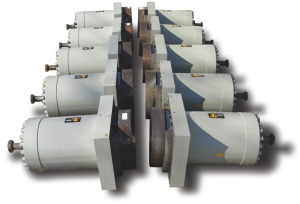
Fix It, Don’t Nix It
By Mark Cook and Tim Patrick
Fluid Power cylinder hydraulicsWhen a hydraulic cylinder breaks down, consider repairing it before replacing it
Cost savings and increases in productivity are crucial if a company is to survive and prosper in today’s economic uncertainty. Hydraulic cylinders, although a small cog in the wheel of industry, are one area where a company can save money by developing and adhering to a maintenance program. And when a cylinder breaks down or wears out, consider the benefits of repairing it instead of buying a new one.
Maximizing the life of a hydraulic cylinder begins with a dedicated approach to maintenance. The biggest culprit in cylinder failure is fluid contamination. This single item accounts for close to 80 percent of all hydraulic cylinder failures. Neglecting to establish a regular fluid inspection schedule and cleanliness target can result in high levels of micron particles that, left unchecked, will eventually score the cylinder rod, cylinder bores and lead to seal failure.

Dependent upon the industry, system, usage and maintenance standards, hydraulic fluid should be checked a minimum of once per quarter and sent out to a lab for an ISO cleanliness test. The fluid will be graded on six levels ranging from two upwards to 50 microns. The results of the test will determine whether the fluid needs to be changed or filtered back to within specifications. In addition, regular inspection of the equipment to ensure that pivot points are greased, rod end connections aren’t working loose from their mounts and that rod boots are in good condition will also help alleviate potential problems.
Over time and regardless of the maintenance schedule, hydraulic cylinders will fail or simply wear out. When that time comes, consider repairing a cylinder instead of buying a new one. The benefits include faster turnaround time, a significant cost savings, and the ability, in many cases, to identify the cause of the failure and make the necessary corrections that will eliminate the problem from occurring again.
In the past, many companies stocked a spare cylinder or two as backup to assure continuity of production; however, in today’s economy, that is no longer a feasible option for most companies. Many instead are turning to specialized repair facilities that offer a 24-hour emergency repair service, and stock a complete selection of parts and materials that enable them to repair a cylinder in a quarter of the time or less than it takes to machine a new replacement. It’s often possible to repair and ship a cylinder within a day or two of receiving the product. The length of time will depend on the size and condition of the unit.
